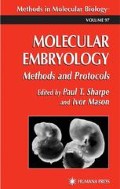Abstract
Cell lineage analyses trace the hierarchy of cell types derived from a progenitor population. Critical to these analyses is the ability to track reliably all or defined subsets of the clonal descendants of the progenitor population. This necessitates marking the cells with a heritable and cell autonomous marker. Transgenes encoding molecules that can be visualized directly in situ without compromising cell differentiation, such as the reporter, β-galactosidase encoded by lacZ, and chloramphenicol acyltransferase, encoded by the CAT gene are the most widely used.
Access this chapter
Tax calculation will be finalised at checkout
Purchases are for personal use only
References
Kothary, R., Clapoff, S., Darling, S., Perry, M. D., Moran, L. A., and Rossant, J. (1988) Inducible expression of an hsp68-lacZ hybrid gene in transgenic mice. Development 105, 707–714.
Tam, P. P. L. and Tan, S.-S. (1992) The somitogenic potential of cells in the primitive streak and the tail bud of the organogenesis-stage mouse embryo. Development 115, 703–715.
Freidrich, G. and Soriano, P. (1991) Promotor traps in embryonic stem cells: a genetic screen to identify and mutate developmental genes in mice. Genes Dev. 5, 1513–1523.
Beddington, R. S. P., Morgenstern, J., Land, H., and Hogan, A. (1989) An in situ enzyme marker for the mid-gestation mouse embryo and the visualisation of inner cell mass clones during early organogenesis. Development 106, 37–46.
Tan, S.-S., Williams, E. A., and Tam, P. P. L. (1993) X-chromosome inactivation occurs at different times in different tissues of the post implantation mouse embryo. Nature Genet. 3, 170–175.
Tan, S.-S. and Breen, S. (1993) Radial mosaicism and tangential cell dispersion both contribute to mouse neocortical development. Nature 362, 638–640.
Stone, L. M., Finger, T. E., Tam, P. P. L., and Tan, S.-S. (1995) Taste receptor cells arise from local epithelium, not neurogenic ectoderm. Proc. Natl. Acad. Sci USA 92, 1916–1920.
Tan, S.-S. Faulkner-Jones, B., Breen, S. J., Walsh, M., Bertram, J. F., and Reese, B. E. (1995) Cell dispersion patterns in different cortical regions studied with an X-inactivated transgenic marker. Development 121, 1029–1039.
Echelard, Y., Vassileva, G., and McMahon, A. P. (1994) Cis-acting regulatory sequences governing Wnt-1 expression in the developing mouse CNS. Development 120, 2213–2224.
Tan, S.-S. (1991) Liver specific and position effect expression of a retinol-binding protein-lacZ fusion gene (RBP-lacZ) in transgenic mice. Dev. Biol. 146, 24–37.
Trainor, P. A., Tain, S.-S., and Tam, P. P. L. (1994). Cranial paraxial mesoderm: regionalisation of cell fate and impact upon craniofacial development in mouse embryos. Development 120, 2397–2408.
Quinlin, G. A., Williams, E. A., Tan, S.-S., and Tam, P. P. L. (1995) Neuroectodermal fate of epiblast cells in the distal region of the mouse egg cylinder: implication for body plan organisation during early embryogenesis. Development 121, 87–948.
Trainor, P. A. and Tam, P. P. L. (1995) Cranial paraxial mesoderm and neural crest cells of the mouse embryo: co-distribution in the craniofacial mesenchyme but distinct segregation in branchial arches. Development 121, 2569–2582.
Berger, C. N., Tan, S.-S., and Sturm, K. S. (1994) Simultaneous detection of b-galactosidase activity and surface antigen expression in viable haematopoietic cells. Cytometry 17, 216–233.
Berger, C. N., Tam, P. P. L., and Sturm, K. S. (1995) The development of haematopoietic cells is biased in embryonic stem cell chimaeras. Dev. Biol. 170, 651–663.
Reese, B. E., Harvey, A. R., and Tan, S.-S. (1995) Radial and tangential dispersion patterns in the mouse retina are class specific. Proc. Natl. Acad. Sci. USA 92, 2494–2498.
Bonnerot, C., Rocancourt, D., Briand, P., Grimber, G., and Nicolas, J. F. (1987) A β-galactosidase hybrid protein targeted to nuclei as a marker for developmental studies. Proc. Natl. Acad. Sci. USA 84, 6795–6799.
Kalderon, D., Roberts, B. L., Richardson, W. D., and Smith, A. E. (1984) A short amino acid sequence able to specify nuclear localisation. Cell 39, 499–509.
Author information
Authors and Affiliations
Editor information
Editors and Affiliations
Rights and permissions
Copyright information
© 1999 Humana Press Inc.
About this protocol
Cite this protocol
Trainor, P.A. et al. (1999). Application of lacZ Transgenic Mice to Cell Lineage Studies. In: Sharpe, P.T., Mason, I. (eds) Molecular Embryology. Methods in Molecular Biology™, vol 97. Humana Press, Totowa, NJ. https://doi.org/10.1385/1-59259-270-8:183
Download citation
DOI: https://doi.org/10.1385/1-59259-270-8:183
Publisher Name: Humana Press, Totowa, NJ
Print ISBN: 978-0-89603-387-0
Online ISBN: 978-1-59259-270-8
eBook Packages: Springer Protocols

